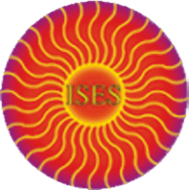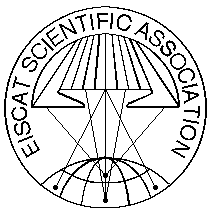
November 28 - December 02, 2011 - Namur, Belgium
Space Climate
| Session: | Session 3B: Space Climate (04) |
| Type: | |
| Date: | Wednesday, November 30, 2011 |
| Time: | 09:00 - 12:30 |
| Chair: | Ilaria Ermolli & Kalevi Mursula |
| Co-chair: | |
| Remarks: |
Splinter Wrap-up: 10:15-10:30 Coffee Break & Poster Session: 10:30-11:15 |
| Seq | Time | Title | Abs No | ||||
| 1 | 09:00 |
Solar Cycle 23 in Perspective: what was so Special and what have we learned from it?
Brandenburg, Axel Nordita, SWEDEN Since the beginnings of systematic recordings of sunspot activity, the solar cycle displayed variations with intervals ranging from 7 to 17 years. In addition, there are longer term variations in the north-south asymmetry of solar activity that modulate the overall activity. Such modulations are also seen in the activity of other late-type stars that are similar to the Sun. Predicting solar activity variations requires a better understanding of of its origin. There are two different schools of either a deeply seated dynamo or one that this distributed throughout the Sun's convection zone, but shaped by the near-surface shear layer in the top 40 megameters. In the latter approach, large-scale magnetic fields are the result of the combined action of systematic properties of many turbulent eddies. Cycle variations are principally a consequence of statistical fluctuations associated with their finite number. In my talk, I will discuss both scenarios, paying particular attention to recent observations the last few cycles. |
Invited | ||||
| 2 | 09:30 |
Do we really understand the Long-Term Trend in Solar Irradiance?
Shapiro, Alexander1; Schmutz, Werner1; Rozanov, Eugene2 1PMOD/WRC, SWITZERLAND; 2PMOD/WRC + IAC ETH, SWITZERLAND The key problem with reconstructing past solar irradiance is the proper treatment of the centennial time-scale component in solar radiation. Long-term changes were suspected as early as the mid-nineteenth century. Nevertheless, the scientific controversy on the magnitude of solar forcing still exists. We give an overview of the reconstructions published over the last decade and discuss their similarities and differences. We present the new approach based on the assumption that the minimum state of the quiet Sun in time corresponds to the observed quietest area on the present Sun. We interpolate between the present quiet Sun and the minimum state of the quiet Sun, using available long-term proxies of the solar activity, which are 10Be isotope concentrations in ice cores and 22-year smoothed neutron monitor data. This determines the long-term trend in the solar variability, which is then superposed with the 11-year activity cycle calculated from the sunspot number. The time-dependent solar spectral irradiance from about 7000 BC to the present is then derived using a state-of-the-art radiation code. These basic assumptions led to a total and spectral solar irradiance that was substantially lower during the Maunder minimum than observed today. The difference between present and Maunder minimum irradiance is remarkably larger than other recent estimations. We discuss the main sources of the uncertainties in the reconstructions of the solar irradiance to the past and observational programs which can help to constrain the estimations of the solar long-term variations. We compare the reconstructed solar variability with the records of stellar photometric variability. |
Invited | ||||
| 3 | 09:50 |
Solar Irradiance Variations as observed by the LYRA Radiometer Onboard PROBA2
Kretzschmar, Matthieu1; Dominique, Marie2; Dammasch, Ingolf2 1ROB / LPC2E, BELGIUM; 2ROB, BELGIUM The LYRA radiometer onboard PROBA2 is observing the solar irradiance in an innovative ways in 4 pass bands that are relevant to space weather and earth climate, from soft X-rays to far ultraviolet. LYRA started its observations several months before SDO, contributing thus significantly to the long term monitoring of solar irradiance. LYRA is furthermore the first radiometer that uses diamond detectors to monitor the solar flux; we will analyze the observed variations of the solar irradiance on the time scale of several solar rotations, and compare with other observations and proxies, in order 1) to better understand the solar variability, and 2) to get a still deeper understanding of the instrument and assess the use of this new technology for long term monitoring of the solar flux. |
|||||
|
10:05 Poster Review |
|||||||
| 4 | 11:15 |
Are the Sunspots really Vanishing ?
Clette, Frédéric; Lefèvre, Laure Royal Observatory of Belgium, BELGIUM The elapsed solar cycle (#23) ended with an exceptionally long period of low activity and with unprecedented low levels for various series of solar irradiance and particle flux measurements. Moreover, since 2000, disagreements appeared among solar reference indices (e.g. Ri and F10.7cm) and in standard solar-based geo-indices (FoF2, TEC proxies). This unpredicted evolution of solar activity raised multiple questions and even speculations about a possible transition to a Grand Minimum. This launched a recent quest for precursor signs of this possible deep solar transition over the last decade during cycle#23. Various results indicate a fading and magnetic weakening of sunspots and a change in their collective behaviour (decay and growth rates, average latitudes). We complete the picture with new evidence of a strong global deficit of the smallest sunspots starting around 2000. We will also synthesize all current solar cycle diagnostics, including the indication of a changed pattern of internal torsional waves (helioseismology), to answer the question: are all sunspots about to disappear? Our conclusions will show the necessity to look backward in time, more than 80 years ago. Indeed, the Sun seems to be actually returning to a past and hardly explored activity regime ending before the 1955-1995 Grand Maximum, which probably biased our current space-age view of solar activity. |
Invited | ||||
| 5 | 11:30 |
On the amplitude and Time of the next Solar Cycle Maximum
Brajsa, Roman1; Verbanac, G.2; Hanslmeier, A.3; Woehl, H.4; Roth, M.4; Ludmany, A.5; Murakozy, J.5; Svalgaard, L.6; MacLeod, C. L.7; Ivezic, Z.7 1Faculty of Geodesy, University of Zagreb, CROATIA; 2Geophysical Institute, Faculty of Science, University of Zagreb, CROATIA; 3IGAM, Institute of Physics, University of Graz, AUSTRIA; 4Kiepenheuer-Institut fuer Sonnenphysik, Freiburg, GERMANY; 5Heliophysical Observatory, Debrecen, HUNGARY; 6HEPL, Stanford University, UNITED STATES; 7Department of Astronomy, University of Washington, Seattle, UNITED STATES For the analysis of the short term variability of solar activity (t<1y, t=1y, t=10y) monthly, monthly smoothed, yearly and corrected yearly values of the relative sunspot number are used. The reduction methods include investigations of (i) asymmetry of the ascending and descending solar cycle phases, (ii) correlation of the relative sunspot number in the minimum and maximum epochs using different time lags, (iii) autoregressive moving average model (ARMA), (iv) damped random walk model (DRW), (v) connection between the starting latitudes and amplitudes of the solar cycles, (vi) relation between the number of spotless days in minima and the amplitude of the next maxima, and (vii) combination of ARMA, DRW, and asymmetry methods. The duration of the solar cycle no. 23 is longer than 12 years (the time span between the last two minima of activity). We estimate that the time difference between the two consecutive maxima, of the cycles no. 23 and no. 24, will be more than 13 years and that the amplitude of the next maximum will be lower than the maximum amplitude of the previous solar cycle. |
|||||
| 6 | 11:45 |
Differences in interplanetary Coronal Mass Ejections during the last two Solar Minima
Kilpua, Emilia University of Helsinki, FINLAND Recent deep and prolonged solar minimum reflected in many ways to heliospheric conditions. In this talk I will give an overview of the consequences of this low solar activity spell to interplanetary coronal mass ejections (ICMEs) using observations from the near-Earth and STEREO spacecraft. Differences in solar activity levels and the Sun's global magnetic field configuration during two last minima affected the near-ecliptic ICME rate as well as the properties and magnetic structure of ICMEs. In addition, generally lower solar wind magnetic field magnitude and total pressure during the recent minimum allowed us to identify smaller and weaker ICME-like structures than has been possible for previous minima. |
Invited | ||||
| 7 | 12:00 |
The Manifestation of topside ionosphere Condition during long-term Solar Minimum.
Rothkaehl, Hanna1; Krankowski, Andrzej2; Przepiorka, Dorota1; Slominska, Ewa1; Gromadzki, Mariusz1; Krypiak-Gregorczyk , Anna2; Sieradzki, Rafal2 1Space Research Center PAS, POLAND; 2University of Warmia and Mazury in Olsztyn, Geodynamics Research Laboratory (GRL/UWM), POLAND
In order to develop a quantitative models of high latitude ionospheric structures, we should enhance our understanding of the rich plasma physical processes occurred in near Earth environment. We should try to understand and describe the global physical processes as well as the small scales plasma instabilities during different solar cycles intervals. The high resolutions plasma particle diagnostics and wave diagnostics located on board of DEMETER satellite, can give us precisely description of trough signatures and instabilities at define point in space. The hybrid method based on wave diagnostics across the whole frequency band, was elaborated using electron and density temperature measurements. This method was applied for determining the trough minimum position, poleward edge and equatorward edge of the main ionospheric trough. Using Langmuir probe DEMETER experiment ISL we develop global maps for electron temperature and density and particle drift velocity for 600 km altitude. Data are represented in geographic coordinates and averaged over one-month period. On the other hand GPS permanent networks such as IGS and EPN provide regular monitoring of the ionosphere in a global scale. Recently, TEC maps have been produced with 5 min intervals and with spatial resolution of 150 â€" 200 km. On other hand the radio occultation techniques located on FormoSat-3/COSMIC (Constellation Observing System for Meteorology, Ionosphere and Climate) is considered. The radio occultation technique using GPS signals has been proven to be a promising technique to retrieve accurate profiles of the ionospheric electron density with high vertical resolution on a global scale. With the ability of performing both rising and setting occultation, FormoSat-3/COSMIC has been producing about 2000 profiles of the ionospheric electron density per day. Moreover in order to obtain the comprehensive picture of the spatial distribution of the ionospheric irregularities at the high latitude ionosphere, GPS Greenland data are added. We are willing to study comparison analysis, that give the statistical background and can be applied for constructing the upper ionospheric emphirical models . |
|||||
| 8 | 12:15 |
Modeling of the atmospheric Response to a strong Decrease of the Solar Activity
Rozanov, Eugene; Egorova, Tatiana; Shapiro, Alexander; Schmutz, Werner PMOD/WRC, SWITZERLAND It was suggested by several publications that the current grand maximum of the solar activity will end within the next 10 to 20 years. Such a change can affect future state of the atmosphere and climate due to an alteration of incoming solar irradiance and energetic particles. On the one hand a decline of the solar activity is expected to be accompanied by a decrease of the spectral solar irradiance leading to cooling and ozone depletion in the stratosphere, a deceleration of the polar night jets and cooler winters over Europe. These effects will be partially compensated by an expected decrease of the geomagnetic activity and less intensive production of nitrogen and hydrogen oxides followed by less intensive ozone destruction and relative warming inside polar vortices. On the other hand an increase of galactic cosmic rays caused by lower solar activity will facilitate ozone destruction and cooling in the polar lower winter stratosphere leading to opposite effects, i.e. to an acceleration of the polar night jets and warmer winters over Europe. To understand the resulting changes in the atmosphere we perform several numerical experiments with chemistry-climate model SOCOL in time-slice mode driven by different combinations of the above-mentioned forcing. The results of these experiments aimed on the analysis of "top-down" mechanisms of solar-climate connection as well as the uncertainty in the applied forcing will be presented and discussed in the talk. |
Invited | ||||











